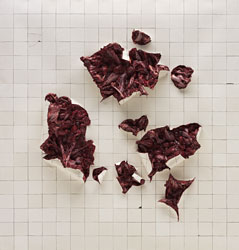2.4
Senior Years Activity
Lucio Fontana and Adriana Varejão

Lucio FONTANA
Argentinian/Italian 1899–1968
Concetto spaziale, Attese (Spatial Concepts) 1965
water-based paint on canvas, white
130 x 97 cm
Solomon R. Guggenheim Foundation
Gift, Fondazione Lucio Fontana
© Courtesy of Fondazione Lucio Fontana
88.3590

Adriana VAREJÃO
Brazilian 1964–
Folds 2 2003
oil on canvas over aluminium, mounted to wood with oil-painted polyurethane
240.7 x 230.2 x 40 cm
Solomon R. Guggenheim Museum, New York
Purchased with funds contributed by the International Director’s Council and Executive Committee Members: Ruth Baum, Edythe Broad, Elaine Terner Cooper, Dimitris Daskalopoulos, Harry David, Gail May Engelberg, Shirley Fiterman, Nicki Harris, Dakis Joannou, Rachel Lehmann, Linda Macklowe, Peter Norton, Tonino Perna, Elizabeth Richebourg Rea, Mortimer D. A. Sackler, Simonetta Seragnoli, David Teiger, and Elliot K. Wolk
© Adriana Varejão, courtesy of Lehmann Maupin Gallery, New York
2003.77
For |
Senior Years Students |
Curriculum |
VCE Art/Studio Arts |
Aim |
To understand the historical context in which this work was produced. |
Preparation |
To do this activity you will need to:
|
Individual Task |
"Just as Fontana turned to matte, monochrome surfaces in order to purify his painting and draw the viewer's attention to the wound in the canvas skin, in Varejão's more recent work, her trompe l'oeil tile walls are aseptic, industrial and pure." Define the term trompe l'oeil. |
Research Questions |
Varejão's work is made after 1970 but responds to the colonial history of Brazil. Her work responds to the troubled and ugly truth about Brazil's history of colonialism, slavery, and racism. This dark history is now largely redeemed by Brazil's political and economical success. Europeans first 'discovered' Brazil in 1500, and it remained a Portuguese colony until the nineteenth century. The sugarcane industry was made profitable only by the forced labour of African slaves. Brazil's indigenous people were banished or assimilated into the Brazilian population. If the ruptures of the otherwise perfectly tiled surface represent the fabric of Brazilian society, what must it mean to find such bodily damage below the surface? Could this be a metaphor for cutting through the falsehoods of history? Discuss. |
Group Task |
Compare the materials, techniques and processes used by Adriana Varejão with that of Lucio Fontana. Note what is similar and what is different about the works, and the artists' aims and approaches. What is distinctive about Fontana and Varejão's work? Discuss your response to this work with others. |